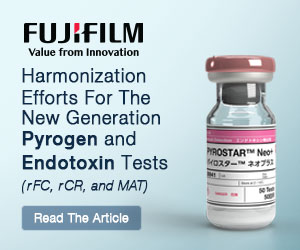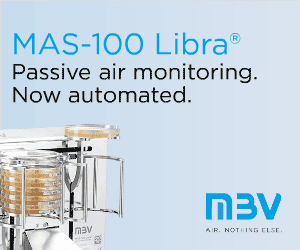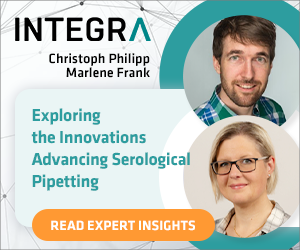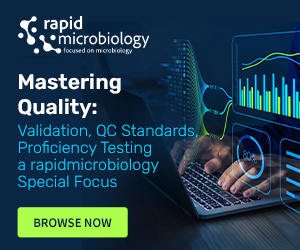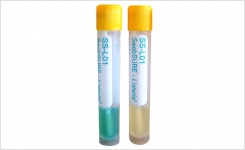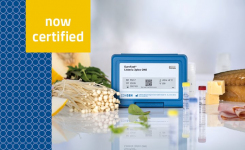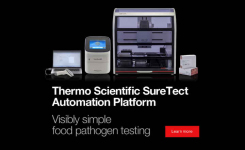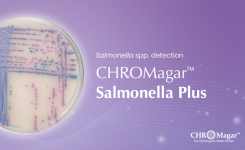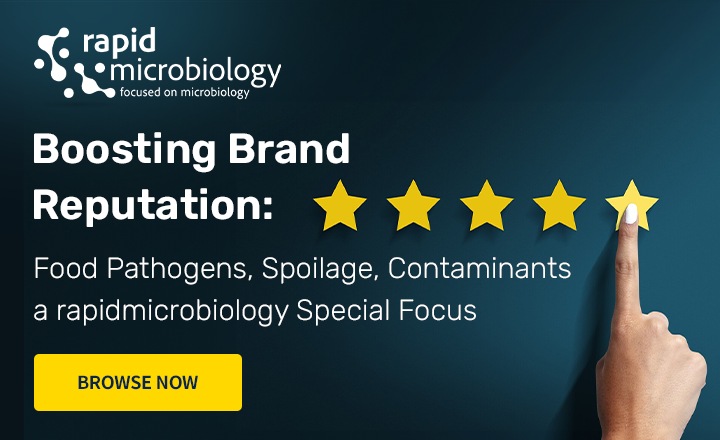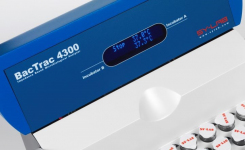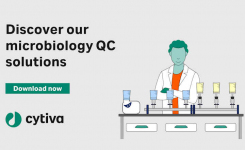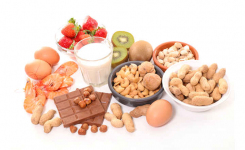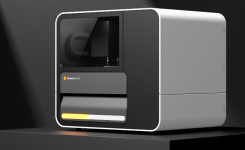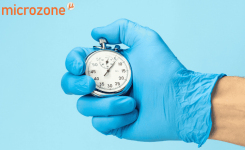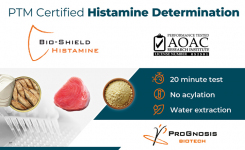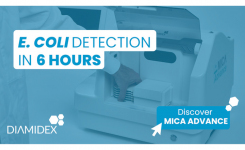Using Molecular Based Kits to Detect Food Pathogens
Key Points
- Rapid - results usually available within 24 hours
- Highly specific - detection based on genetic identifiers
- Sensitive - capable of detecting a single cell in a 25g sample
- User friendly - suitable for full automation and able to run simultaneous assays for several pathogens
- Development potential - new technologies promise more rapid and flexible detection methods
 Food microbiology laboratories have changed considerably during the last 30 years. In the early 1980s the focus was on quality control testing, much of which was done in-house by manufacturers. But as the industry began to adopt the HACCP approach to food safety management, quality control was replaced by quality assurance. Prevention, rather than detection of contamination, became the goal of food safety control and much of the remaining microbiological testing was outsourced. This trend was in part driven by the limitations of traditional microbiological methods, especially for foodborne pathogens. Conventional methods continued to rely on culturing the microorganisms in a sample to produce sufficient cells for detection. That culture step meant that the total time taken for any microbiological test is at least 24 hours – for some pathogens it is five days or more – limiting the role that microbiological testing can play in food safety and quality assurance. Conventional tests can never provide results quickly enough to monitor critical control points in a HACCP system effectively, and are now used mainly to verify that the system is working correctly.
Food microbiology laboratories have changed considerably during the last 30 years. In the early 1980s the focus was on quality control testing, much of which was done in-house by manufacturers. But as the industry began to adopt the HACCP approach to food safety management, quality control was replaced by quality assurance. Prevention, rather than detection of contamination, became the goal of food safety control and much of the remaining microbiological testing was outsourced. This trend was in part driven by the limitations of traditional microbiological methods, especially for foodborne pathogens. Conventional methods continued to rely on culturing the microorganisms in a sample to produce sufficient cells for detection. That culture step meant that the total time taken for any microbiological test is at least 24 hours – for some pathogens it is five days or more – limiting the role that microbiological testing can play in food safety and quality assurance. Conventional tests can never provide results quickly enough to monitor critical control points in a HACCP system effectively, and are now used mainly to verify that the system is working correctly.
Nevertheless, the demand for microbiological testing in the food industry has never been greater. Common foodborne pathogens like Campylobacter and Salmonella continue to cause widespread illness, while less common organisms, notably Listeria monocytogenes and Shigatoxin/Vero toxin producing E. coli (STEC/VTEC) have been responsible for very serious foodborne disease outbreaks in Europe and North America. Increasing food production, concerns over food safety, legislative requirements and the demands of large retailers have all driven an increase in microbiological testing, especially for specific pathogens. According to recent reports by market analysts Strategic Consulting, an estimated 275 million food microbiology tests were carried out in the EU in 2011, while in the USA over 213 million tests were performed in 2010. This is thought to account for over half of the entire microbiological testing market and the proportion of that testing that is pathogen-specific is rising at a rate three times greater than that of the total. This demand for more testing has inevitably created a growing need for test methods that provide results more quickly, yet the standard reference methods used for enforcement testing are still mostly based on conventional culture techniques.
In the last ten years, culture based pathogen detection has faced a growing challenge from molecular methods, especially those based on detecting elements of the microbial genome. While molecular testing has yet to overhaul conventional methods in food microbiology, the pace of technological change is driving the development of new techniques that will soon allow that to happen. Some of these already exist as commercial products.
Molecular detection technologies
PCR - The key discovery in the development of molecular biology in the 1980s was the polymerase chain reaction or PCR. The PCR provides a means of synthesising multiple copies of (amplifying) a specific piece of DNA. It made the speedy detection of very small quantities of DNA in a sample not only possible, but also practical. A more detailed description of PCR and the development of practical microbial detection methods employing it can be found in our PCR for the Food Microbiology Laboratory Test Method Guide
A PCR-based detection method consists of three stages as follows:
1. DNA extraction - A process designed to lyse any cells of the target pathogen in the sample and release bacterial DNA. This can be difficult in a food matrix, especially when pathogens are present in low numbers. This step typically includes a DNA purification procedure and many commercial test protocols still require an enrichment culture stage before extraction to increase the number of bacterial cells.
2. DNA amplification - During this step the PCR is used to produce multiple copies of the target DNA sequence (often a single gene highly specific to the pathogen concerned). This is done by alternately raising and lowering the temperature (thermo-cycling) to facilitate the binding of primers to the target sequence and its duplication by a DNA-polymerase enzyme. By repeating this process 30-40 times enough DNA for detection can be generated in a few hours.
3. DNA detection - Once sufficient copies of the target sequence have been produced they can be detected. Some methods rely on end-point detection, where the amplified target sequences are separated by electrophoresis and visualised by a staining technique. However, many commercial test protocols employ real-time detection, in which the amplification and detection steps are combined, typically by using a 'fluorescent reporter probe' to monitor the amplification process and indicate a detection when the number of copies produced reaches a threshold level. Real-time detection also allows testing for more than one pathogen in the same assay by using probes labelled with different coloured dyes.
Real-time PCR assays for food microbiology have been developed into commercial products whereby some or all of the steps can be automated to minimise the number of operations involved and reduce the risk of contamination. Automation requires a higher capital investment and so will depend on the sample throughput required. The reaction usually takes place inside a computer-controlled combined thermocycler/fluorescence detection instrument and uses pre-prepared reagents. For foodborne pathogen detection tests, the entire process can be completed within 20-30 hours with sufficient sensitivity to detect a single cell in a 25g sample.
The main advantage for PCR-based methods is in shorter detection times, but the high degree of automation built into PCR systems also allows relatively unskilled staff to run them without extensive training. The high specificity of PCR can also mean fewer repeat tests. The principal disadvantage is currently cost, both in terms of capital outlay and consumables. While larger laboratories can benefit from reduced labour costs, economies of scale and rapid results, the benefits for smaller labs may be less clear.
A number of commercial PCR systems are currently offered for food pathogen detection. One of the first into the marketplace was the Bax® system from Hygiena and this has been joined by TaqMan® and MicroSEQ® food pathogen detection kits from Life Technologies, iQ Check real-time PCR kits from Bio-Rad, foodproof® real-time PCR detection kits distributed by Merck, and several others.
Recent developments in PCR-based detection
One of the main reasons for the comparatively high capital cost of PCR-based detection systems is the need for thermocycling during the amplification step. Instruments must be capable of very accurate and precise temperature control throughout the cycle. In addition to the capital investment for the instrumentation, the chemistry is also expensive as it uses fluorescent probes. Novel developments in DNA synthesis have demonstrated alternative solutions for DNA amplification under isothermal conditions without the need for a thermocycler. There are several types of nucleic acid amplification technologies. Amongst the isothermal DNA amplification technologies that have been developed, loop-mediated isothermal amplification (LAMP) has been used widely to detect microorganisms and is a promising and suitable technology for the rapid detection of pathogen in the field. LAMP uses multiple primers and a bacterial polymerase, Bst polymerase, derived from Bacillus stereothermophilus to amplify DNA rapidly at a constant 63oC. This does away with the need for a thermocycler component in the instrument and can reduce the cost by up to two thirds.
A commercial isothermal amplification system has already been developed for food pathogen detection. The 3M™ Molecular Detection System uses a unique bioluminescence method to detect the amplification of DNA sequences and is designed to be simple to use. The amplification and detection processes are completed within 75 minutes with real-time positive results available as early as 15 minutes. An overnight single enrichment step is still required at present. Test kits for E. coli O157 including H7, Salmonella and Listeria spp. detection in food and environmental samples are currently available.
Portable PCR-based instruments have also been developed recently. For example, BioFire markets the 'Ruggedized Advanced Pathogen Identification Device' or R.A.P.I.D.® System, which uses an air thermocycling process and a fluorimetric detection system to detect Salmonella, Listeria, E. coli O157 and Campylobacter in food samples.
Other technologies
While PCR is the cornerstone of molecular pathogen detection, other techniques have also been used to develop commercial products.
rRNA-based detection Ribosomal RNA (rRNA) is more abundant in bacterial cells than the DNA of the genome, but can be equally specific to individual species. This means that detection of specific rRNA sequences has the potential to provide more rapid detection than conventional PCR, but with no loss of sensitivity. Targeting rRNA forms the basis of the automated Atlas™ Detection System developed by Roka Bioscience using hybridisation technology licensed from GenProbe. The target sequences are amplified not by PCR, but using a technique called transcription-mediated amplification, which is both rapid and isothermal. The detection system uses labelled oligonucleotides probes. Assays for Salmonella and Listeria are currently available.
Microarrays Microarrays, sometimes referred to as lab-on-a-chip technology, were initially developed as a tool to measure gene expression. However, since they are essentially molecular detectors, they also have a wide range of other potential applications, including pathogen detection. A microarray consists of a solid matrix usually a glass slide or a filter, on which a number of oligonucleotide probes or other DNA fragments are placed in very precise locations at high density. Target DNA sequences in a sample are then hybridised to the probes and detected by fluorescence. This technology is especially useful for screening DNA target sequences produced by PCR from samples. Microarrays can distinguish DNA from target species from non-specific sequences and can detect many different sequences in a single assay.
Veredus laboratories in Singapore are currently developing a commercial foodborne pathogen detection system based on microarray technology. VereFoodborne™ is reported to be portable and able to detect 10-12 different pathogens in a single test within two hours. Microarrays may also have food safety applications as protein detectors, since they could be used to detect microbial antigens and bacterial toxins in food samples.
Sequencing techniques The most important application of DNA sequencing techniques in food microbiology at present is in the typing of foodborne pathogens, especially during food poisoning outbreaks. Techniques such as multi locus sequence typing (MLST) and ribotyping are widely used and are described in more detail in our Microbial Identification and Strain Typing Using Molecular Techniques Test Method Guide but sequencing technology is developing rapidly and may soon have broader food safety applications.
Next generation sequencing (NGS) for example is much faster and less costly than conventional Sanger sequencing and is able to sequence an entire microbial genome in a few days. Commercial NGS platforms such as Life Technologies semiconductor-based Ion Torrent PGM™ system are already available and could be used to help track a specific strain of a foodborne pathogen through the food supply chain.
Get the latest updates in Rapid Microbiological Test Methods sent to your email? Subscribe to the free rapidmicrobiology eNewsletter


